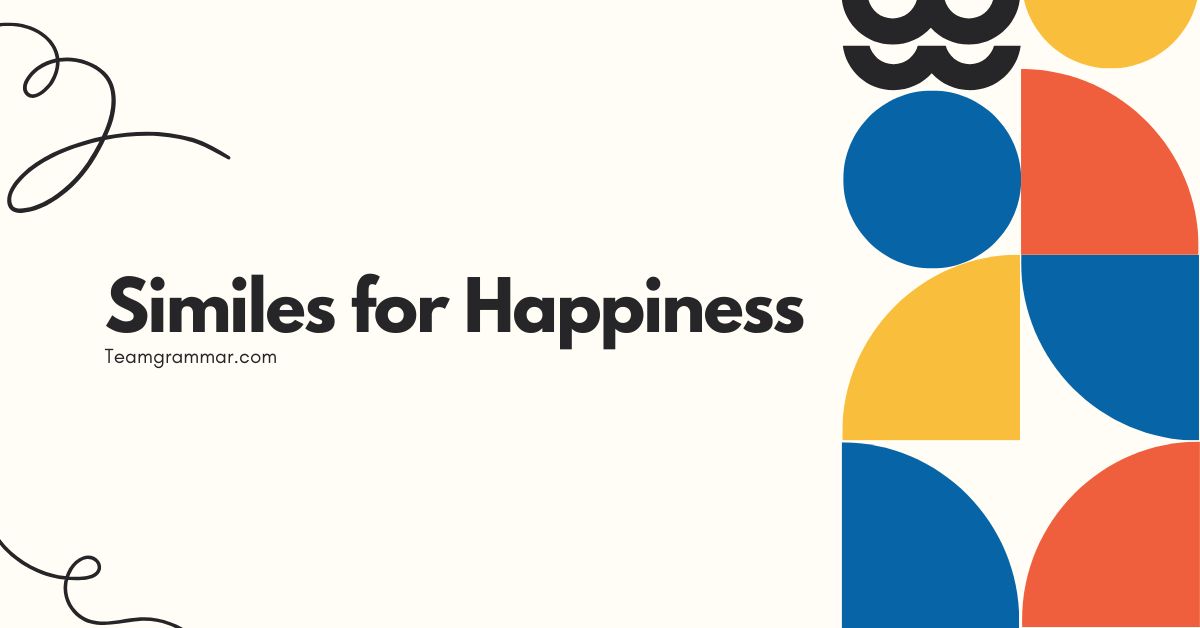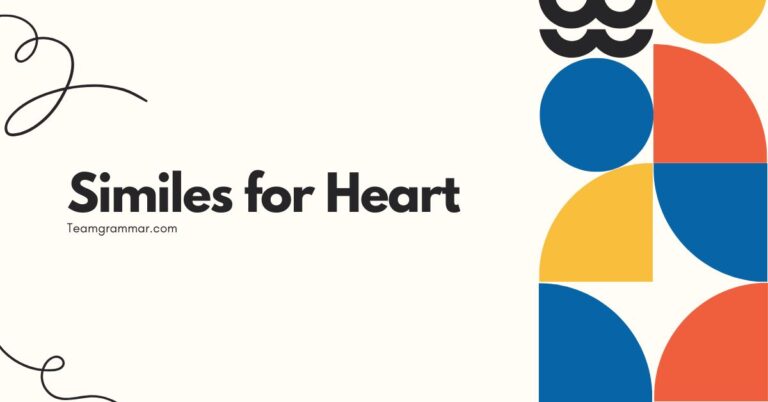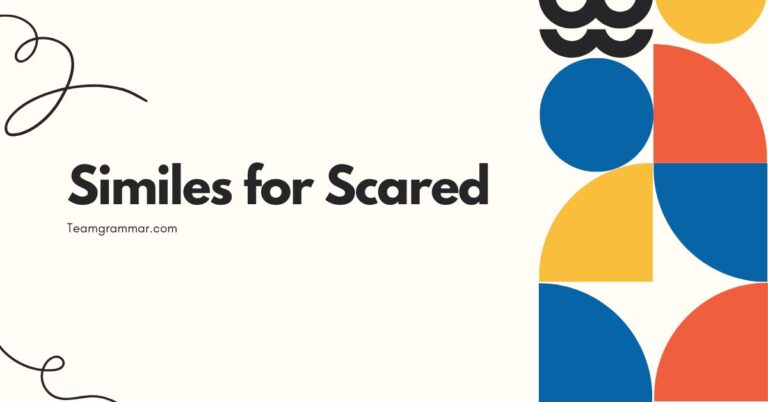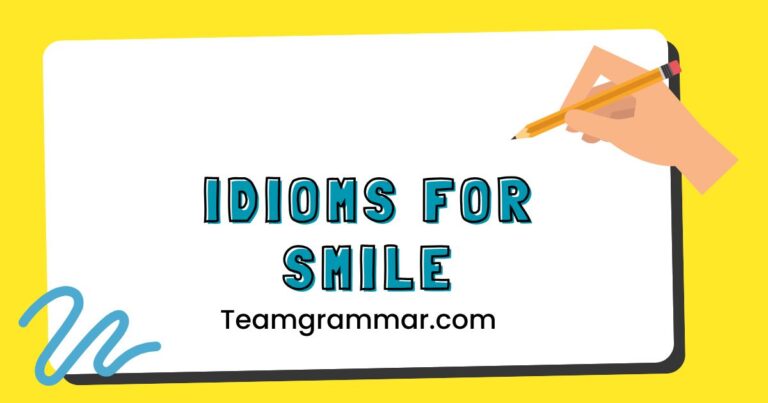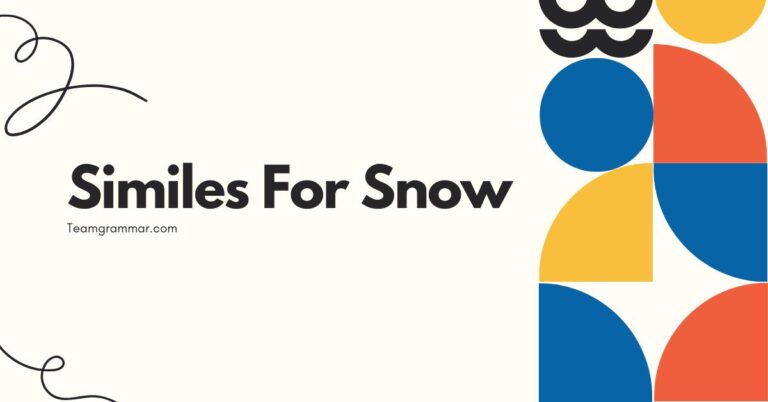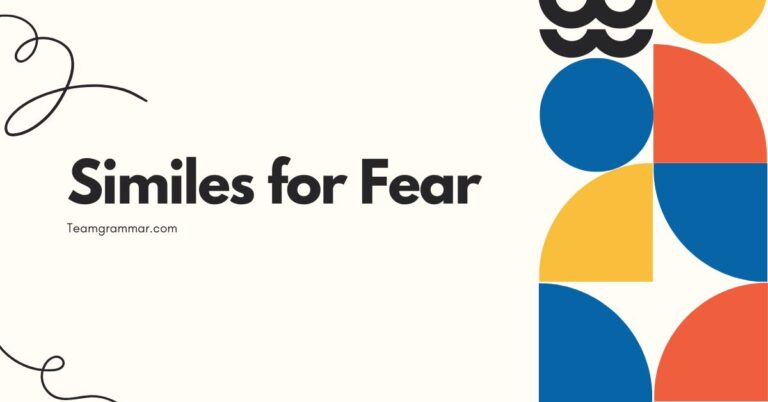38 Similes for Happiness: A Comprehensive Grammar Guide
Understanding similes is crucial for enriching your descriptive language and adding vividness to your writing and speech. Similes, a type of figurative language, allow you to draw comparisons between seemingly unrelated things, creating a more engaging and expressive style.
This article focuses on similes that describe happiness, providing you with the tools to articulate joy and contentment in creative and memorable ways. Whether you’re a student learning the basics of figurative language, a writer seeking to enhance your prose, or simply someone who enjoys exploring the nuances of the English language, this guide will help you master the art of using similes to convey happiness.
This article will delve into the definition of similes, their structural components, and various examples specifically crafted to depict happiness. We will examine how these similes function, the different types that exist, and the common mistakes to avoid.
Furthermore, we will provide practical exercises to reinforce your understanding and usage. By the end of this comprehensive guide, you’ll be well-equipped to use similes effectively to express happiness in your writing and conversation.
Table of Contents
- Definition of a Simile
- Structural Breakdown of Similes
- Types of Similes
- Similes for Happiness
- Usage Rules for Similes
- Common Mistakes with Similes
- Practice Exercises
- Advanced Topics in Similes
- Frequently Asked Questions
- Conclusion
Definition of a Simile
A simile is a figure of speech that directly compares two different things using the words “like” or “as.” The purpose of a simile is to create a vivid and imaginative connection between the two subjects, enhancing the reader’s or listener’s understanding and appreciation. Similes are a fundamental tool in descriptive writing and are widely used in literature, poetry, and everyday conversation to make language more engaging and expressive.
Similes are classified as a type ofanalogy, which is a broader term for drawing comparisons between things. However, unlike metaphors, which imply that one thingisanother, similes only suggest a resemblance or similarity.
The function of a simile is to illuminate a particular characteristic or quality by associating it with something more familiar or relatable. For instance, saying “He is as brave as a lion” uses the well-known bravery of a lion to emphasize the man’s courage.
Similes can be used in various contexts to add depth and color to descriptions. They are particularly effective in evoking emotions, painting mental images, and making abstract concepts more concrete.
Whether you’re describing a feeling, a place, or a person, similes can significantly enhance the impact of your words. For example, describing happiness as “feeling like you’re floating on a cloud” provides a sensory experience that goes beyond a simple statement of joy.
Structural Breakdown of Similes
Understanding the structure of a simile is essential for using it effectively. A typical simile consists of three key components: thesubject, thelinking word(like or as), and theobject of comparison.
The subject is the thing being described, and the object of comparison is what the subject is being compared to. The linking word establishes the connection between the two.
The basic formula for a simile is: Subject + Linking Word (like/as) + Object of Comparison. For example, in the simile “Her smile was as bright as the sun,” “her smile” is the subject, “as” is the linking word, and “the sun” is the object of comparison.
This structure allows for a clear and direct comparison, making the simile easy to understand and appreciate.
Similes can also be more complex, incorporating additional descriptive elements. For instance, you might add adjectives or adverbs to further refine the comparison.
Consider the simile “He was as happy as a clam at high tide.” Here, the adjective “happy” modifies the subject, and the phrase “at high tide” provides additional context to the object of comparison, enhancing the imagery and emotional impact.
Types of Similes
Similes can be categorized based on the type of comparison they make or the effect they create. While there aren’t strict classifications, some common types include descriptive similes, emotional similes, and hyperbolic similes.
Each type serves a slightly different purpose in enhancing your writing.
Descriptive Similes
Descriptive similes focus on physical attributes or characteristics. They aim to create a vivid image in the reader’s mind by comparing the subject to something with similar visual or sensory qualities.
For example, “The snow was as white as a sheet” is a descriptive simile that emphasizes the color of the snow.
Emotional Similes
Emotional similes are used to convey feelings and emotions. They compare the subject’s emotional state to something that evokes a similar feeling.
For instance, “She felt as light as a feather” is an emotional simile that describes a feeling of happiness and freedom.
Hyperbolic Similes
Hyperbolic similes use exaggeration to emphasize a particular quality. They compare the subject to something that is obviously exaggerated, creating a humorous or dramatic effect.
An example is “He was as hungry as a horse,” which exaggerates the person’s hunger.
Similes for Happiness
Similes are excellent tools for describing happiness in various forms. They allow you to convey the intensity, nuances, and specific qualities of joy and contentment.
Here are several categories of similes for happiness, each designed to capture a different aspect of this complex emotion.
Joyful and Exuberant Similes
These similes emphasize intense, overflowing happiness. They often involve comparisons to things that are energetic, lively, and full of life.
The table below provides a comprehensive list of similes that describe joyful and exuberant happiness. These examples use vivid imagery to convey a sense of intense delight and excitement.
| Simile | Explanation |
|---|---|
| As happy as a lark | Describes someone extremely cheerful and carefree. |
| As excited as a kid in a candy store | Conveys the thrill and anticipation of being in a delightful environment. |
| As gleeful as a winning lottery player | Expresses the overwhelming joy of unexpected success. |
| As thrilled as a bride on her wedding day | Captures the special happiness associated with a significant life event. |
| As elated as a graduate receiving their diploma | Describes the sense of accomplishment and joy from achieving a major goal. |
| As jovial as Santa Claus | Evokes the image of someone who is constantly cheerful and generous. |
| As ecstatic as a fan meeting their idol | Conveys the intense joy of encountering someone greatly admired. |
| As merry as a Christmas carol | Describes a happiness that is festive and celebratory. |
| As delighted as a child opening presents | Captures the pure, innocent joy of receiving gifts. |
| As jubilant as a team winning a championship | Expresses the collective joy and excitement of a major victory. |
| As cheerful as a sunny morning | Relates happiness to the pleasant and uplifting feeling of a bright day. |
| As happy as a clam at high tide | Describes someone who is content and secure in their environment. |
| As giddy as a schoolgirl | Conveys a lighthearted, almost silly happiness. |
| As pleased as punch | An idiom expressing great satisfaction and delight. |
| As tickled as a feather | Describes a light, amusing happiness. |
| As bubbly as champagne | Conveys a lively, effervescent happiness. |
| As festive as a parade | Describes a celebratory, joyous atmosphere. |
| As sparkling as fireworks | Expresses a radiant, dazzling happiness. |
| As animated as a cartoon character | Conveys an energetic, lively happiness. |
| As enthusiastic as a cheerleader | Describes an energetic, supportive happiness. |
| As thrilled as winning a contest | Expresses the joy that comes from success and recognition. |
| As joyous as a choir singing | Describes a harmonious, uplifting happiness. |
| As exultant as a triumphant hero | Conveys a feeling of victory and great joy. |
| As gleeful as a child on a swing | Describes the simple, carefree joy of childhood. |
| As happy as a bug in a rug | An idiom expressing extreme comfort and contentment. |
| As merry as a band of musicians | Describes a fun-loving, cheerful group. |
| As delighted as receiving good news | Conveys the happiness that comes from positive information. |
| As jubilant as a crowd cheering | Expresses the collective excitement and joy of a large group. |
| As cheerful as a blooming garden | Relates happiness to the beauty and vibrancy of nature. |
Peaceful and Content Similes
These similes describe a more serene and tranquil form of happiness. They often involve comparisons to things that are calm, quiet, and soothing.
The following table provides examples of similes that evoke a sense of peaceful and content happiness. These similes often use imagery related to nature and tranquility.
| Simile | Explanation |
|---|---|
| As content as a cat purring | Describes a deep sense of satisfaction and relaxation. |
| As peaceful as a still lake | Conveys a sense of calm and serenity. |
| As serene as a mountain vista | Describes a tranquil and majestic happiness. |
| As calm as a sleeping baby | Captures the innocence and peace of undisturbed rest. |
| As relaxed as a spa day | Expresses the feeling of being completely at ease and stress-free. |
| As tranquil as a meditation session | Describes a happiness that comes from inner peace and mindfulness. |
| As mellow as a sunset | Conveys a gentle, warm, and calming happiness. |
| As quiet as a library | Describes a serene and undisturbed happiness. |
| As still as a sleeping forest | Captures the quiet beauty and peace of nature. |
| As untroubled as a clear sky | Expresses a happiness free from worries and concerns. |
| As restful as a vacation | Describes the rejuvenating and peaceful feeling of being away from stress. |
| As composed as a zen master | Conveys a sense of inner peace and self-control. |
| As soothed as by a gentle breeze | Describes a calming and comforting happiness. |
| As placid as a pond’s surface | Conveys a serene and undisturbed state of mind. |
| As balanced as a perfectly tuned instrument | Describes a harmonious and stable happiness. |
| As hushed as a snowfall | Captures the quiet, peaceful beauty of falling snow. |
| As settled as dust | Describes a feeling of being at peace and content. |
| As mild as a spring day | Conveys a gentle, pleasant, and calming happiness. |
| As quiet as the countryside | Describes a serene and undisturbed happiness. |
| As unshaken as a mountain | Conveys a sense of stability and inner strength. |
| As comforted as by a warm fire | Describes a cozy and soothing happiness. |
| As undisturbed as a sleeping cat | Captures the peacefulness of undisturbed rest. |
| As serene as a lotus flower | Describes a tranquil and beautiful happiness. |
| As relaxed as lying in a hammock | Expresses the feeling of being completely at ease. |
| As calm as the eye of a storm | Conveys a sense of peace amidst chaos. |
| As still as a statue | Describes a serene and undisturbed happiness. |
| As untroubled as a child’s dream | Expresses a happiness free from worries and fears. |
| As restful as a long sleep | Describes the rejuvenating and peaceful feeling of deep rest. |
| As composed as a wise old tree | Conveys a sense of inner peace and stability. |
Lighthearted and Playful Similes
These similes describe a fun, carefree, and amusing form of happiness. They often involve comparisons to things that are whimsical, entertaining, and joyful.
The table below showcases similes that describe the lighthearted and playful aspects of happiness, evoking feelings of fun and amusement.
| Simile | Explanation |
|---|---|
| As playful as a kitten | Describes a happiness that is full of energy and fun. |
| As whimsical as a fairy tale | Conveys a sense of enchantment and lightheartedness. |
| As amusing as a clown | Describes a happiness that is entertaining and funny. |
| As carefree as a summer breeze | Captures the feeling of being without worries or responsibilities. |
| As lighthearted as a comedy show | Expresses a happiness that is enjoyable and humorous. |
| As jovial as a court jester | Describes a happiness that is cheerful and entertaining. |
| As silly as a cartoon | Conveys a happiness that is amusing and lighthearted. |
| As bubbly as soda pop | Describes a happiness that is effervescent and fun. |
| As giddy as a child on a carousel | Captures the lighthearted joy of a fun ride. |
| As whimsical as a Dr. Seuss book | Expresses a happiness that is imaginative and playful. |
| As playful as dolphins in the sea | Describes a happiness that is full of energy and joy. |
| As amusing as a stand-up comedian | Conveys a happiness that is entertaining and humorous. |
| As carefree as a bird in flight | Captures the feeling of freedom and joy. |
| As lighthearted as a children’s song | Expresses a happiness that is simple and enjoyable. |
| As jovial as a friendly game | Describes a happiness that is cheerful and fun. |
| As silly as a slapstick routine | Conveys a happiness that is amusing and lighthearted. |
| As bubbly as a glass of sparkling water | Describes a happiness that is effervescent and refreshing. |
| As giddy as riding a roller coaster | Captures the thrill and joy of an exciting ride. |
| As whimsical as a dream | Expresses a happiness that is imaginative and lighthearted. |
| As playful as puppies | Describes a happiness that is full of energy and fun. |
| As amusing as a funny movie | Conveys a happiness that is entertaining and humorous. |
| As carefree as a summer day | Captures the feeling of being without worries or responsibilities. |
| As lighthearted as a joke | Expresses a happiness that is simple and enjoyable. |
| As jovial as a party | Describes a happiness that is cheerful and festive. |
| As silly as a funny face | Conveys a happiness that is amusing and lighthearted. |
| As bubbly as a laughing child | Describes a happiness that is effervescent and joyful. |
| As giddy as dancing in the rain | Captures the lighthearted joy of a spontaneous moment. |
| As whimsical as a child’s drawing | Expresses a happiness that is imaginative and playful. |
Radiant and Glowing Similes
These similes describe happiness that is outwardly visible and bright. They often involve comparisons to things that shine, glow, and illuminate.
The following table presents similes that describe the radiant and glowing aspects of happiness, emphasizing its outward visibility and brightness.
| Simile | Explanation |
|---|---|
| As radiant as the sun | Describes a happiness that is bright and illuminating. |
| As glowing as a firefly | Conveys a sense of inner light and joy. |
| As luminous as a star | Describes a happiness that shines brightly. |
| As sparkling as diamonds | Captures the dazzling and brilliant quality of happiness. |
| As bright as a lightbulb | Expresses a happiness that is clear and intense. |
| As beaming as a lighthouse | Describes a happiness that guides and illuminates. |
| As incandescent as a flame | Conveys a happiness that is warm and radiant. |
| As shimmering as gold | Describes a happiness that is precious and beautiful. |
| As gleaming as a polished surface | Captures the pristine and flawless quality of happiness. |
| As lustrous as pearls | Expresses a happiness that is elegant and refined. |
| As effulgent as a sunrise | Describes a happiness that is radiant and new. |
| As aglow as embers | Conveys a sense of warm and comforting happiness. |
| As coruscating as crystals | Describes a happiness that is sparkling and clear. |
| As incandescent as lava | Captures the intense and fiery quality of happiness. |
| As illuminated as a stained glass window | Expresses a happiness that is colorful and beautiful. |
| As radiant as a smile | Describes a happiness that is bright and expressive. |
| As glowing as a candle | Conveys a sense of warmth and hope. |
| As luminous as the moon | Describes a happiness that is gentle and calming. |
| As sparkling as morning dew | Captures the fresh and pure quality of happiness. |
| As bright as a sunny day | Expresses a happiness that is clear and uplifting. |
| As beaming as a proud parent | Describes a happiness that is full of love and pride. |
| As incandescent as a starburst | Conveys a happiness that is explosive and radiant. |
| As shimmering as a lake in the sun | Describes a happiness that is beautiful and serene. |
| As gleaming as a new car | Captures the pristine and exciting quality of happiness. |
| As lustrous as silk | Expresses a happiness that is smooth and elegant. |
| As effulgent as a supernova | Describes a happiness that is intensely radiant. |
| As aglow as a fireplace | Conveys a sense of cozy and comforting happiness. |
| As coruscating as a waterfall | Describes a happiness that is dynamic and clear. |
Free and Unburdened Similes
These similes describe happiness that comes from a sense of freedom and release from burdens. They often involve comparisons to things that are light, airy, and unrestricted.
The following table showcases similes that describe the free and unburdened aspects of happiness, emphasizing the feeling of liberation and lightness.
| Simile | Explanation |
|---|---|
| As free as a bird | Describes a happiness that is unrestricted and unburdened. |
| As unburdened as a feather | Conveys a sense of lightness and freedom from worries. |
| As liberated as a released prisoner | Describes a happiness that comes from freedom and release. |
| As light as air | Captures the feeling of being weightless and free. |
| As unrestricted as the open sky | Expresses a happiness that is limitless and expansive. |
| As unfettered as a wild horse | Describes a happiness that is untamed and free-spirited. |
| As unconfined as a flowing river | Conveys a sense of freedom and natural movement. |
| As unbound as a wild spirit | Describes a happiness that is untethered and free. |
| As untethered as a balloon | Captures the feeling of floating freely. |
| As unchained as a runaway train | Expresses a happiness that is unstoppable and free. |
| As unburdened as a cloud | Describes a happiness that is light and carefree. |
| As liberated as a rescued animal | Conveys a sense of relief and newfound freedom. |
| As light as a dandelion seed | Describes a happiness that is delicate and free-floating. |
| As unrestricted as a clear road | Captures the feeling of having no obstacles in the way. |
| As unfettered as a free thought | Expresses a happiness that is uninhibited and creative. |
| As unconfined as an ocean | Describes a happiness that is vast and limitless. |
| As unbound as a soaring eagle | Conveys a sense of power and freedom. |
| As untethered as a kite | Captures the feeling of being lifted and free. |
| As unchained as a revolutionary | Expresses a happiness that is bold and transformative. |
| As unburdened as a sigh of relief | Describes a happiness that comes from release and relief. |
| As liberated as a released songbird | Conveys a sense of freedom and joy. |
| As light as a whisper | Describes a happiness that is gentle and free-flowing. |
| As unrestricted as a blank canvas | Captures the feeling of limitless potential. |
| As unfettered as a dancer’s movement | Expresses a happiness that is graceful and free. |
| As unconfined as a horizon | Describes a happiness that is expansive and boundless. |
| As unbound as a creative idea | Conveys a sense of limitless possibility. |
| As untethered as a hot air balloon | Captures the feeling of floating and exploring freely. |
| As unchained as a free spirit | Expresses a happiness that is independent and bold. |
Usage Rules for Similes
Using similes effectively requires adherence to certain rules to ensure clarity and impact. While similes are a creative tool, they should be used judiciously to avoid clichés and maintain originality.
Here are some key usage rules to keep in mind:
- Ensure a Clear Comparison: The two things being compared should have a recognizable similarity. The connection should be logical and easily understood by the audience. For example, comparing “happiness to a warm blanket” works because both evoke feelings of comfort and security.
- Avoid Clichés: Overused similes, such as “as busy as a bee” or “as strong as an ox,” can diminish the impact of your writing. Strive for originality by creating fresh and unique comparisons.
- Maintain Consistency: The simile should fit the tone and context of your writing. A simile that is too outlandish or incongruous can disrupt the flow and distract the reader.
- Use Sparingly: While similes can enhance your writing, overuse can make it seem forced and artificial. Use them strategically to emphasize key points and create vivid imagery.
- Consider Your Audience: The effectiveness of a simile depends on the audience’s familiarity with the object of comparison. Choose comparisons that are relatable and understandable to your intended readers or listeners.
Similes should enhance understanding and bring clarity to the description. A poorly constructed simile can be confusing or misleading.
Make sure the comparison is relevant and adds value to your writing.
Common Mistakes with Similes
Even experienced writers can make mistakes when using similes. Recognizing and avoiding these common errors can significantly improve the quality of your writing.
The following table outlines some common mistakes made when using similes, along with examples of both incorrect and correct usage.
| Mistake | Incorrect Example | Correct Example | Explanation |
|---|---|---|---|
| Using a Metaphor Instead of a Simile | Her happiness was the sun. | Her happiness was *as bright as* the sun. | Metaphors state that one thing *is* another, while similes use “like” or “as” to make a comparison. |
| Using a Vague Comparison | He was happy like something. | He was *as happy as* a lark. | The object of comparison should be specific and create a clear image. |
| Using Clichéd Similes | She was as happy as possible. | She was *as happy as* a child opening presents. | Avoid overused similes to maintain originality and impact. |
| Inconsistent Tone | He was as happy as a clam, but also very sad. | He was *as happy as* a clam, enjoying the peaceful afternoon. | Ensure the simile fits the overall tone and context of your writing. |
| Overusing Similes | He was as happy as a lark, like a bird in flight, and as cheerful as sunshine. | He was *as happy as* a lark, his joy filling the room. | Use similes sparingly to avoid making your writing seem forced. |
| Unclear Comparison | The day was like happiness. | The day was *as bright as* happiness itself. | Ensure the comparison is specific and adds value to the description. |
| Illogical Comparison | He was as happy as a rock. | He was *as happy as* a kid in a candy store. | The comparison should be logical and easily understood. |
| Misusing “Like” and “As” | He felt as he was happy. | He felt *as if* he was happy. | Use “like” and “as” correctly to establish the comparison. |
Practice Exercises
To reinforce your understanding of similes for happiness, try the following exercises. These exercises will help you practice identifying, creating, and using similes effectively.
Exercise 1: Identify the Simile
Read the following sentences and identify the simile in each. Underline the two things being compared.
| Question | Answer |
|---|---|
| 1. Her laughter was as bright as sunshine. | Laughter, sunshine |
| 2. He felt as free as a bird after finishing his exams. | He, bird |
| 3. Their joy was like a warm embrace. | Joy, embrace |
| 4. She was as happy as a clam at high tide. | She, clam |
| 5. His smile was as radiant as the sun. | Smile, sun |
| 6. They were as content as cats purring by the fire. | They, cats |
| 7. The children were as playful as puppies in the park. | Children, puppies |
| 8. Her heart felt as light as a feather. | Heart, feather |
| 9. He was as elated as a graduate receiving their diploma. | He, graduate |
| 10. Their happiness spread like wildfire through the crowd. | Happiness, wildfire |
Exercise 2: Complete the Simile
Complete the following sentences by adding an appropriate object of comparison to create a simile.
| Question | Answer |
|---|---|
| 1. She was as happy as a ____. | She was as happy as a lark. |
| 2. He felt as content as ____. | He felt as content as a cat purring. |
| 3. Their joy was like ____. | Their joy was like a warm summer day. |
| 4. She was as radiant as ____. | She was as radiant as the sun. |
| 5. He felt as free as ____. | He felt as free as a bird. |
| 6. They were as playful as ____. | They were as playful as puppies. |
| 7. The children’s laughter was like ____. | The children’s laughter was like music to my ears. |
| 8. She was as lighthearted as ____. | She was as lighthearted as a comedy show. |
| 9. He was as jubilant as ____. | He was as jubilant as a team winning a championship. |
| 10. Their happiness shimmered like ____. | Their happiness shimmered like gold. |
Exercise 3: Create Your Own Similes
Write your own similes for the following scenarios, describing the type of happiness experienced.
| Scenario | Your Simile |
|---|---|
| 1. Winning a lottery. | |
| 2. Watching a beautiful sunset. | |
| 3. Playing with a pet. | |
| 4. Graduating from college. | |
| 5. Spending a day at the beach. | |
| 6. Receiving a heartfelt gift. | |
| 7. Listening to your favorite music. | |
| 8. Achieving a personal goal. | |
| 9. Spending time with loved ones. | |
| 10. Helping someone in need. |
Here are some example answers. Note that many answers are possible.
| Scenario | Your Simile |
|---|---|
| 1. Winning a lottery. | As gleeful as a winning lottery player. |
| 2. Watching a beautiful sunset. | As mellow as a sunset. |
| 3. Playing with a pet. | As playful as a kitten. |
| 4. Graduating from college. | As elated as a graduate receiving their diploma. |
| 5. Spending a day at the beach. | As relaxed as a spa day. |
| 6. Receiving a heartfelt gift. | As delighted as a child opening presents. |
| 7. Listening to your favorite music. | As joyous as a choir singing. |
| 8. Achieving a personal goal. | As exultant as a triumphant hero. |
| 9. Spending time with loved ones. | As comforted as by a warm fire. |
| 10. Helping someone in need. | As beaming as a lighthouse. |
Advanced Topics in Similes
Once you have a solid understanding of the basics, you can explore more advanced techniques to enhance your use of similes. These include extended similes, metaphorical similes, and using similes in creative writing.
Extended Similes
An extended simile is a simile that is developed over several lines or even an entire paragraph. Instead of a brief comparison, the writer elaborates on the similarities between the two things being compared, creating a more detailed and vivid image.
Extended similes are particularly effective in poetry and descriptive prose, where the goal is to immerse the reader in the scene.
Example:
Metaphorical Similes
A metaphorical simile combines the qualities of both a simile and a metaphor. While it uses “like” or “as” to make a comparison, the comparison is often more abstract and symbolic.
This technique can add depth and complexity to your writing, inviting the reader to interpret the comparison on multiple levels.
Example:
Similes in Creative Writing
In creative writing, similes can be used to enhance character development, set the scene, and evoke emotions. They can also be used to create unique and memorable descriptions that set your writing apart.
Experiment with different types of similes and don’t be afraid to break the rules to achieve a desired effect.
Frequently Asked Questions
Conclusion
Similes are powerful tools for expressing happiness and adding depth to your writing. By understanding the structure, types, and usage rules of similes, you can effectively convey the nuances of joy and contentment.
Practice creating your own similes, experiment with advanced techniques, and always strive for originality. With these skills, you’ll be well-equipped to use similes to bring your descriptions of happiness to life.

